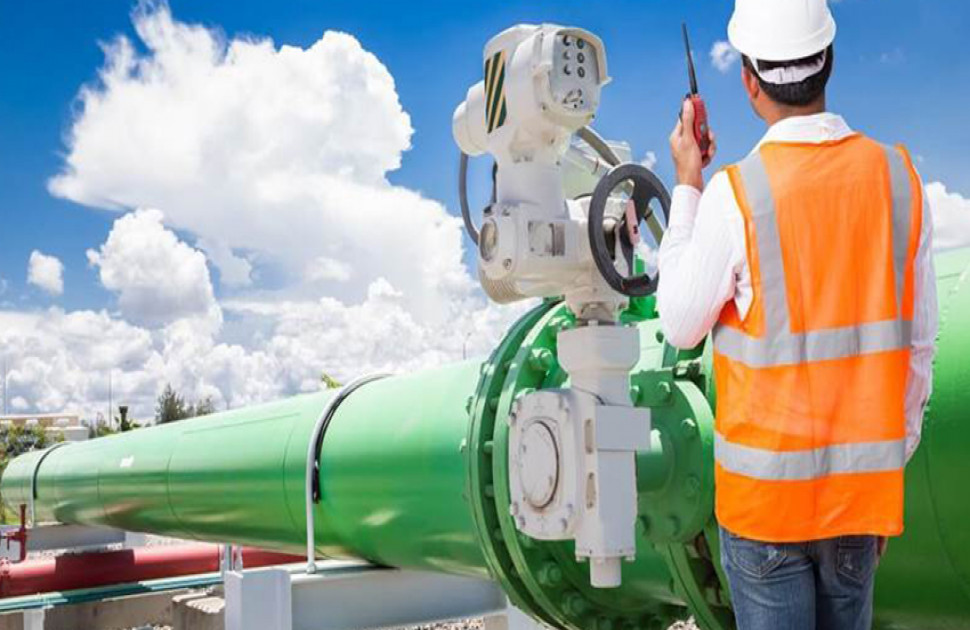Pipeline integrity management systems are crucial for ensuring the safe and reliable operations of piping networks. In the oil and gas industry, numerous regulations require asset owners to periodically assess the integrity of certain pipelines. (For more on pipeline regulation, read The Impact of the Pipeline Safety Act of 2011 on the Industry.) One of the most common and universally accepted methods for performing these assessments is hydrostatic pressure testing.
Hydrostatic pressure testing, or more specifically, post-construction hydrotesting, is a process that uses water to exert pressure on a pipeline at levels greater than the pipeline's normal operating pressure. Leaks may be identified as drops in hydrostatic pressure along the pipe or visually by using dye as a visual aid. For in-service pipelines, post-construction pressure tests can highlight existing defects as well as verify the adequacy of the installation.
While post-construction hydrotesting can deliver immediate results, this method has significant drawbacks. Firstly, shutting down a section of the pipeline for testing is costly. The act of removing pipe sections, installing test heads, pressurizing the pipe, dewatering, and finally reinstating pipe sections, requires extensive downtime. In the petrochemical industry, in particular, lengthy shutdown periods can be extremely expensive.
The Dangers of Post-Construction Hydrostatic Testing
While the cost implications of hydrostatic testing are a concern, it pales in comparison to the safety and environmental hazards associated with this testing method.
Pressure testing is inherently destructive in nature. The pipeline is subjected to higher than normal pressures, forcing existing defects to fail. This has several implications.
Firstly, pressurizing the pipeline to its maximum limit can amplify existing defects or create defects that may not have appeared during normal operation. Even more problematic is that these new or worsened defects may not immediately fail the hydrostatic test, and thus remain undetected as the pipe is put back in operation.
Additionally, post-construction hydrotesting ruptures the pipeline where defects exist, causing fluid to leak into the surrounding soil. This seepage can have devastating consequences on nearby structures and infrastructure such as highways, bridges and building foundations.
Perhaps one of the most dangerous aspects of post-construction hydrostatic testing is the risk it presents to the safety of on-site workers. Intense pressure buildup in the line can result in the sudden and unintended release of stored energy. The presence of cracks, failing joints, faulty valves, loose fittings, etc. exponentially increase this risk. Some of the potential safety hazards associated with hydrostatic pressure testing include:
- Flying pipe components, such as valves, gauges, flanges, fittings
- Flying shrapnel from ruptured pieces of pipe
- Potential flooding in areas where energized electrical utilities are present
How Ultrasonic Inline Inspection Technology Enhances Safety
Ultrasonic inline inspections (ILI) involve using ultrasound waves to assess the pipeline's integrity. These sound waves, which are emitted by a transducer, propagate through pipeline material. When the sound waves encounter a boundary (such as a crack), portions of it are reflected back to the transducer and converted to an electrical signal.
Ultrasonic testing is classified as a nondestructive test. In other words, the pipeline can be assessed safely without compromising its current integrity. (Read a case study about this type of test in the article Use of Non-intrusive Inspection in Onshore Gas Facilities.) Because inline ultrasonic inspections do not involve pressurization, the risk of a high-pressure rupture is eliminated, ensuring the safety of nearby workers as well as the general public.
Furthermore, since no fluids are used during the pipe inspection, there is no chance of leakage into the surrounding soil. Therefore, adverse effects such as environmental contamination and settlement of nearby structures are not a concern.
Using Advanced Ultrasonic Technologies to Further Improve Inspection Safety
While traditional ultrasonic inspections methods address many of the safety deficiencies of post-construction hydrostatic testing, there are limitations to this technology. Complex features, such as tilted and hook cracks, are difficult to detect using conventional inline ultrasonic tools.
This shortcoming is due to the operating principle of older inspection equipment. In previous ultrasonic technology generations, ultrasonic wave signals were emitted at a specific angle. This made it difficult to detect and adequately size cracks of various orientations.
However, some ultrasonic technology providers, like NDT Global, have developed propriety technologies capable of addressing the shortcoming of conventional ultrasonic inspection techniques. NDT’s Eclipse UCx solution, for example, uses a sensor arrangement that provides deeper insights into defects that were previously considered to be "hard-to-detect."
In contrast to conventional ultrasonic inline inspection tools, where only a single signal is used, the Eclipse UCx emits two signals that work in unison to record defect information. As the robot moves through the pipeline, the dual signal interacts with the pipe material. Upon striking a feature, one signal bounces back to sensor "A," while the unshielded part of the signal continues to travel through the material and is intercepted at sensor "B." This specific arrangement makes it possible to collect detailed data regardless of crack orientation.
When used in conjunction with other integrity management program components, ILI technologies, like the Eclipse UCx, can be used as a safer and more economical replacement for post-construction hydrostatic testing.
Final Thoughts
Any operation that places a structure under pressure is inherently hazardous. The sudden and unintended discharge of stored energy can cause violent ruptures that release high-velocity projectiles. Furthermore, forcing the pipe to fail under pressure can result in the formation of new defects and encourage the growth of existing features. To make matters worse, fluid leakage from hydrostatic testing can contaminate the surrounding environment and jeopardize nearby structures.
ILI technologies provide pipeline asset owners with a solution that can replace destructive pressure testing methods. By eliminating two of the most damaging components of hydrotesting – water and pressure – operators can sustain the longevity of their pipelines and enhance their integrity management programs with little to no risk to workers or the environment.
As ultrasonic technology continues to advance, we can expect inline inspections to become more precise and eventually replace destructive pipeline testing methods.









